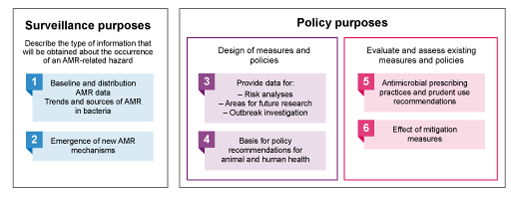2.1 Purposes of AMR surveillance and monitoring in animals
There are many reasons why we may want to conduct surveillance. The purpose of a surveillance system describes why it is necessary and what it will accomplish. Surveillance activities should be designed for a specific purpose.
There are different ways to classify the various purposes of surveillance systems. Figure 4 is based on the terrestrial and aquatic animal health codes (OIE, 2019) which suggests six classifications of surveillance purposes – numbered in the figure – based on what surveillance will accomplish.

Figure 4 Overview of the purposes of AMR surveillance and monitoring, based on OIE and RISKSUR classifications.
Show description|Hide descriptionSurveillance purposes include baseline and distribution AMR data, trends and sources of AMR in bacteria, and the emergence of new AMR mechanisms. Policy purposes include designing measures and policies to provide data for risk analyses, areas for future research and outbreak investigation, and as a basis for policy recommendations for animal and human health; policy purposes also include evaluating and assessing existing measures and policies, such as antimicrobial prescribing practices and prudent use recommendations, and the effect of mitigation measures.
In addition, the RISKSUR consortium – a group of European experts in animal health surveillance, part of a project called Risk-based Animal Health Surveillance Systems [Tip: hold Ctrl and click a link to open it in a new tab. (Hide tip)] – described the purposes as either a surveillance purpose, describing information to be obtained about occurrence of a health hazard (such as resistant bacteria), or a policy purpose, which describes how surveillance information is used by policy-makers to inform policy objectives (Hoinville, 2013).




